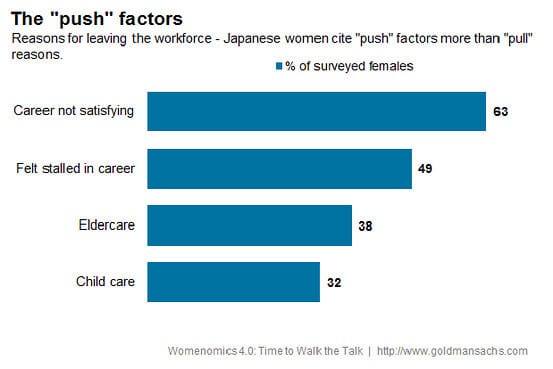Kathy Matsui Dispels 3 Myths About Japanese Working Women
In case you missed Kathy Matsui at our Womenomics event last month, here are some of the main points from her talk.
(Original blog post written by Kelly Kikuchi for wahlandcase.com.)
Her brief talk, “Womenomics: Myths, Progress and the Path Forward”, traced the history of the term “Womenomics” and how it informed Japanese Prime Minister Abe’s economic policy. She then unpacked and dispelled three myths about Japanese women in the workforce before opening up the floor to a lively and extended Q&A session. For many of the 100 or so guests, this was unprecedented access to a gracious mind of extraordinary power.
What is Womenomics?
Womenomics is the concept Kathy Matsui first put forward in 1999. It proposes a path to significantly increasing Japan’s GDP (as much as 13%) through the promotion of women in the workforce
The myth-busting element is an especially fruitful exercise. It is so easy to let one’s self slip back into unsubstantiated thought patterns and stereotypes. It’s so valuable that it’s worth repeating here. Let’s unpack these myths and then stop believing them.
3 Myths About Japanese Women in the Workforce
Myth #1: Women drop out of the workforce due to pull factors rather than push factors.
In this context, “pull factors” the two major factors considered to be pulling women out of the workforce in developed nations are child care and elder care. “Push factors” are considered to be reasons

women are pushed out of their positions, which include not feeling satisfied with their job and feeling stalled in their careers.
In Japan, 63% of women surveyed listed lack of satisfaction in their position as a reason for exiting their job, in contrast to the 32% citing lack of childcare (Image via WSJ). So while Abenomics has made great strides in increasing the number of spots available in Japanese nurseries, we are treating an issue rather than curing it. Curing it would involve businesses and organizations taking a long, hard look in the mirror and sussing out why women are feeling stalled and dissatisfied to the point of opting out altogether.
Myth # 2: Diversity in the workforce has no impact on corporate performance or the economy
Many rebuttals to gender related executive quota schemes given by men is that if women and men are equals, it shouldn’t matter how many of the executives are women. That the time, effort and expense required to bring more women into top positions couldn’t possibly be offset by any gains said diversity might bring to the bottom line.
Matsui then presented the research to prove the opposite is true: the higher the number of female managers the organization has, the higher the return on equity it has. True for Fortune 500 firms, and true across Japan.
Myth # 3: More working women would further depress the already low birth rate in Japan
Japan already has a famously low birthrate, a problem so severe that even startups are springing up to tackle the problem. This one seems like a no-brainer (albeit rank with sexist double standards). A woman who is passionate about her career would choose to have fewer children (or none at all) in order to devote herself to work. Thus, more working women would necessitate a lower birth rate.
In fact, the opposite is true. Countries with more women in the workforce have consistently higher fertility rates, both amongst developed nations and in Japan.
Despite the persistent myths and misdirected efforts, Matsui admitted during the lengthy and lively Q&A session that she is optimistic about the future.
As a part of the onboarding process for new recruits at the Tokyo office, she often leads Q&A session as part of Goldman Sachs’ orientation. She has seen the balance of new employee even out to a 50/50 gender split, as well as seen the types of lead questions flip.
She noted that last year the first question came from a young man sitting the front row, who proceeded to ask how to best time having a family when both he and his partner would like to excel in their careers.
“This younger generation has power,” says Matsui. “Their values are different.”



